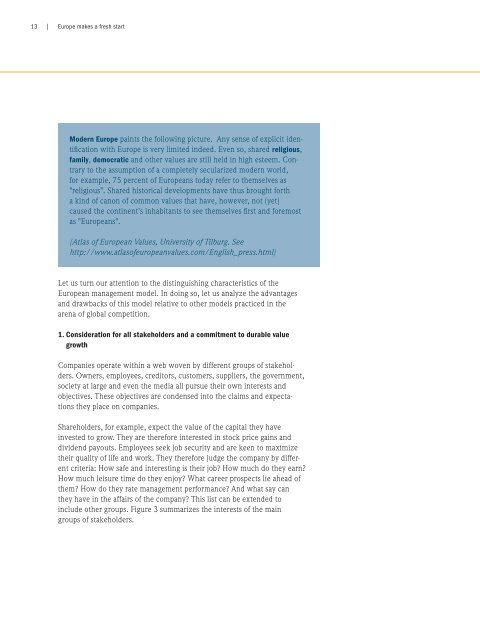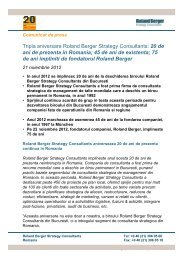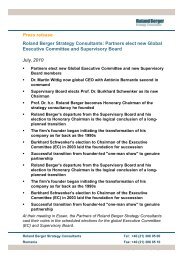Europe makes a fresh start - Roland Berger Strategy Consultants
Europe makes a fresh start - Roland Berger Strategy Consultants
Europe makes a fresh start - Roland Berger Strategy Consultants
You also want an ePaper? Increase the reach of your titles
YUMPU automatically turns print PDFs into web optimized ePapers that Google loves.
13 |<br />
<strong>Europe</strong> <strong>makes</strong> a <strong>fresh</strong> <strong>start</strong><br />
Modern <strong>Europe</strong> paints the following picture. Any sense of explicit identification<br />
with <strong>Europe</strong> is very limited indeed. Even so, shared religious,<br />
family, democratic and other values are still held in high esteem. Contrary<br />
to the assumption of a completely secularized modern world,<br />
for example, 75 percent of <strong>Europe</strong>ans today refer to themselves as<br />
"religious". Shared historical developments have thus brought forth<br />
a kind of canon of common values that have, however, not (yet)<br />
caused the continent's inhabitants to see themselves first and foremost<br />
as "<strong>Europe</strong>ans".<br />
(Atlas of <strong>Europe</strong>an Values, University of Tilburg. See<br />
http://www.atlasofeuropeanvalues.com/English_press.html)<br />
Let us turn our attention to the distinguishing characteristics of the<br />
<strong>Europe</strong>an management model. In doing so, let us analyze the advantages<br />
and drawbacks of this model relative to other models practiced in the<br />
arena of global competition.<br />
1. Consideration for all stakeholders and a commitment to durable value<br />
growth<br />
Companies operate within a web woven by different groups of stakeholders.<br />
Owners, employees, creditors, customers, suppliers, the government,<br />
society at large and even the media all pursue their own interests and<br />
objectives. These objectives are condensed into the claims and expectations<br />
they place on companies.<br />
Shareholders, for example, expect the value of the capital they have<br />
invested to grow. They are therefore interested in stock price gains and<br />
dividend payouts. Employees seek job security and are keen to maximize<br />
their quality of life and work. They therefore judge the company by different<br />
criteria: How safe and interesting is their job? How much do they earn?<br />
How much leisure time do they enjoy? What career prospects lie ahead of<br />
them? How do they rate management performance? And what say can<br />
they have in the affairs of the company? This list can be extended to<br />
include other groups. Figure 3 summarizes the interests of the main<br />
groups of stakeholders.






